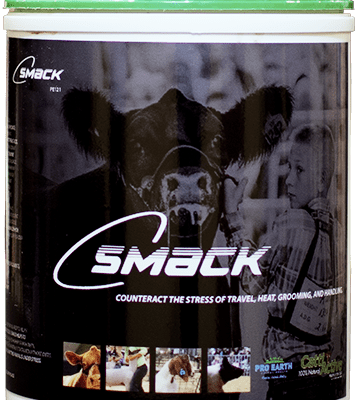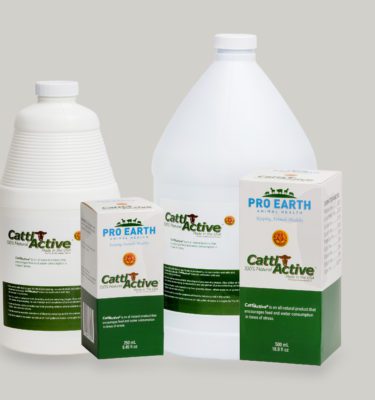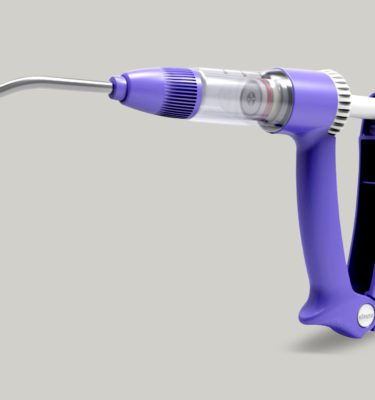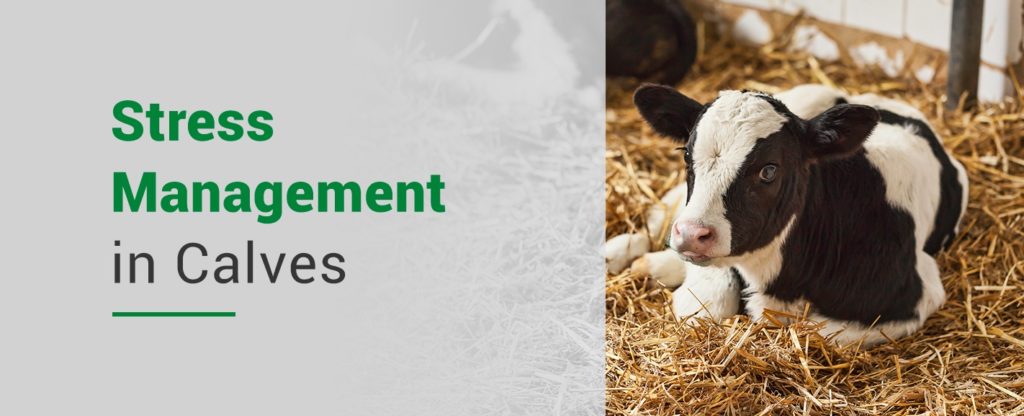 In the cattle industry, stress among livestock is one of the top issues producers face. Stressors can hinder the overall productivity and health of cattle. Calves may be even more susceptible to the adverse effects of stress. Fortunately, producers can take steps for stress management for a calf to reduce its stress levels.
In the cattle industry, stress among livestock is one of the top issues producers face. Stressors can hinder the overall productivity and health of cattle. Calves may be even more susceptible to the adverse effects of stress. Fortunately, producers can take steps for stress management for a calf to reduce its stress levels.
Jump to Key Section
What Is Stress?
Stress refers to the symptoms that result from an environment or situation that is not normal for an animal. Think of stress as an external influence that impacts the homeostasis of a system. Stress can manifest physically and psychologically in cattle. Some of the physical changes that occur as a result of stress are the release of cortisol, adrenaline and other hormones. A psychological manifestation of stress is fear of specific objects, environments or situations.
Causes of stress include:
- A triggering event
- Socialization
- Hunger
- Sickness
- Injury
- Thirst
- Fatigue
- Temperature extremes
Fear can come from triggering events such as restraint, transportation, handling, neglect, noise, unfamiliar objects and a variety of other causes. As such, restraint and handling are two of the most significant topics of concern when it comes to lowering cattle stress.
High levels of stress, especially prolonged stress, can have long-term negative impacts on cattle, such as a weakened immune system, reduced reproduction, weight loss, digestive upsets, inflammatory reactions and reduced feed consumption.
Stress can make cattle unhappy and unhealthy, resulting in less productivity and the potential for disease outbreak. Animals instinctively want to maintain homeostasis, which means they may respond to external changes to re-balance the body’s internal system. For example, when experiencing heat stress, cattle may drink more water and seek out shade. Collectively, we call these stress-reducing behaviors thermoregulation.
Thermoregulation has its limits. For one, thermoregulation is easier for animals on hot days than cold ones. A cow can only do so much on its own to reduce stress from external factors. Because stress can have a significant negative impact on a herd, owners should take steps to minimize stress among cattle.
Effects of Stress on Cattle
How does stress affect the overall health of cattle and calves? What are the implications of stressed cattle on growing livestock and the quality of life the cows have? The following are effects of stress on cattle.
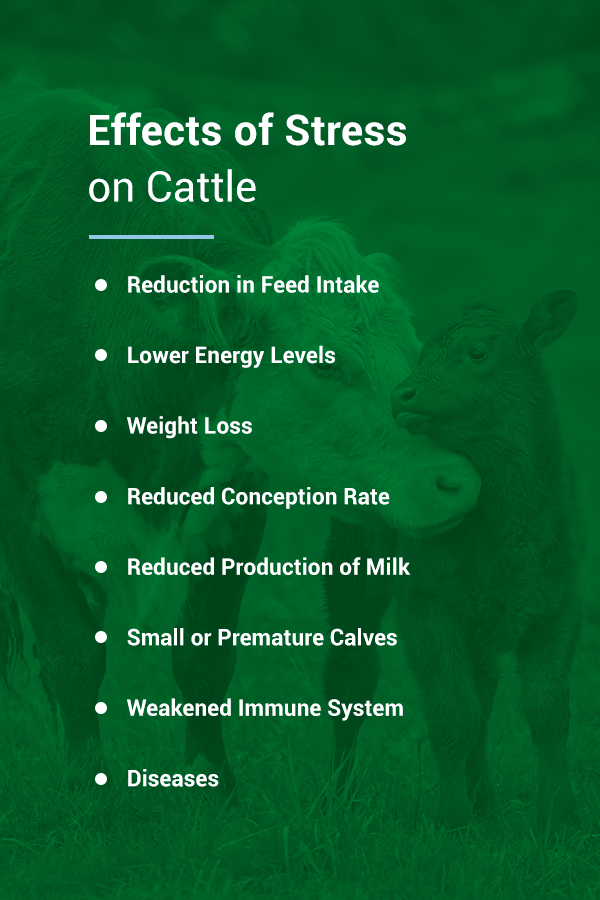 Reduction in Feed Intake
Reduction in Feed Intake
When cows suffer from stress, they may experience a loss of appetite. When cattle are coping with high temperatures in hot weather, for example, they consume less feed. This reduction in feed intake can decrease a cow’s production of fatty acids and cause ruminal acidosis.
Lower Energy Levels
A decrease in the rate of consumption of feed also leads to lower energy levels in cattle. Cows and calves become lethargic and less productive. The fat content in a cow’s milk may also become compromised, as well as their milk production.
Weight Loss
Stress can also lead to weight loss in cattle. In cold weather, the loss of an insulating layer of body fat can make a cow or calf more susceptible to the frigid conditions. The animal may not be able to keep itself sufficiently warm or be productive.
Reduced Conception Rate
When cows feel stressed, the success rate of insemination drops. Producers will have fewer calves and productivity will slow.
Reduced Production of Milk
When stressed, dairy cows may also produce less milk. Heat stress, which typically occurs in summer months, can be a cause of reduced milk production. Because stress causes a loss of appetite, cows have less energy and aren’t able to produce milk at the same rate. This lack of productivity can have a significant impact on a producer’s livelihood, making this a sign of much concern.
Small or Premature Calves
Another effect of stress on cattle is that calves may be born premature or small. Stress among cattle could make growing viable, productive livestock more difficult for producers.
Weakened Immune System
Prolonged stress can also result in a weakened immune system in cattle. Cortisol levels increase due to stress, compromising the animal’s immune system. As a result, stressed cows and calves are more likely to get sick.
Though vaccines are common in the livestock industry to prevent disease, a stressed animal has a less effective response to pathogens than an unstressed one. Often, a stressed animal with a large concentration of cortisol will still not have an effective immune response, even with a vaccine. This animal can still get sick and spread diseases to the rest of the herd.
Calves are particularly susceptible to contracting diseases from other cattle, so ensuring the entire herd is healthy is especially important to maintain healthy calves.
Diseases
Stress-related diseases include coccidiosis, pasteurellosis and Mannheimia haemolytica. The cow’s immune system typically keeps these under control. When an immune system becomes compromised by stress, however, this may result in the animal contracting one of these diseases.
Pasteurellosis is more common in calves, especially those that are being weaned. Weaning can be a stressful time on calves, and this stress can leave these young animals vulnerable to disease. Pasteurellosis is frequently a cause of economic loss. Mannheimia haemolytica causes lung infection and a form of pneumonia in stressed animals.
These diseases may cause the following symptoms:
- Weight loss
- Fever
- Nasal discharge
- Coughing
- Rapid breathing
- Morbidity
Young animals are also more vulnerable to coccidiosis. This parasitic disease tends to occur when calves move from a pasture to a feedlot. While the animal is unlikely to die, it will likely have a low production rate. Symptoms may include:
- Dehydration
- Malaise
- Emaciation
- Diarrhea that may include mucus and blood
Cows and calves can face severe consequences when suffering from stress. A stressed cow can become less productive, sick or even die. To prevent disease or loss among your cattle, you should know the signs of stress in cattle.
12 Signs of Stress in Cattle
What are the signs of stress in cows? To keep your livestock healthy, happy and productive, you should be aware of the symptoms of stress in cattle. Knowing what to look for will allow you to deal with an animal’s stress as soon as it manifests and improve the conditions of the animal’s environment.
1. Respiratory Issues
Sick cow symptoms often include respiratory issues. Calves are especially vulnerable to breathing problems, particularly in cold weather or climates. Respiratory issues could result from heat stress, cold stress or sickness. Breathing problems can be one of the most telling signs of stress in calves.
2. Standing While Other Cows Are Lying Down
Is your cow or calf behaving abnormally compared to the rest of the herd? One sign of stress in cattle is standing while the other cows are lying down.
3. Frequent Urination
When stressed, cattle may urinate more frequently than usual. Cattle tend to increase their water intake when stressed, so frequent urination could be a sign of stress to look for.
4. Rapid Heart Rate
Another telling sign of stress in a cow or calf is an increased heart rate. The animal could be suffering from an adrenaline-induced stressor or heat stress.
5. Trembling
Cattle may also tremble when suffering from stress. Shaking could be a fear response to a stressful trigger. Cows will remember an object, situation or environment that caused a fear response in them before, and trembling could be a sign of fear of that object or environment. Trembling could also be a sign of weather stress if the animal is in an ordinary situation where a stressful trigger is absent.
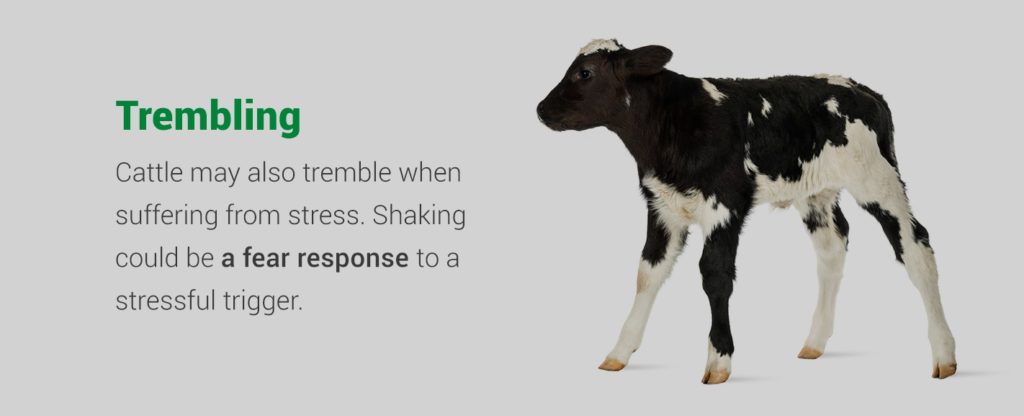 6. Seeking out Shade
6. Seeking out Shade
Are your cattle clustering together under a shady tree? On a hot, sunny day, this could mean cattle are experiencing heat stress. They want to find a cooler spot away from the sun so they can return their body temperature to the right range for homeostasis.
7. Open-Mouthed Breathing
If your cattle are breathing with open mouths, this may be another sign of stress, particularly heat stress.
8. Slobbering
The increased production of saliva is another indicator of stress. Make sure cows are out of direct sunlight and have access to enough water to keep them hydrated.
9. Lack of Coordination
Dealing with a few clumsy cows? Lack of coordination is a severe sign of heat stress. This condition can lead to collapse and even coma or death. If you notice your cattle beginning to stumble around, take immediate action.
10. Restlessness
Cows can also become restless and agitated when coping with stress. You may be unable to get the animal to lay down, and its productivity levels will drop. Handling and managing the animal may also become more difficult, so do your best to prevent external factors that may cause cattle to become restless or agitated.
11. Splashing Water
On a hot day, a cow splashing water may be a sign of heat stress. Because cattle don’t produce adequate sweat to cool themselves off, they may seek ways to get moisture on their bodies that can then evaporate, allowing them to cool down.
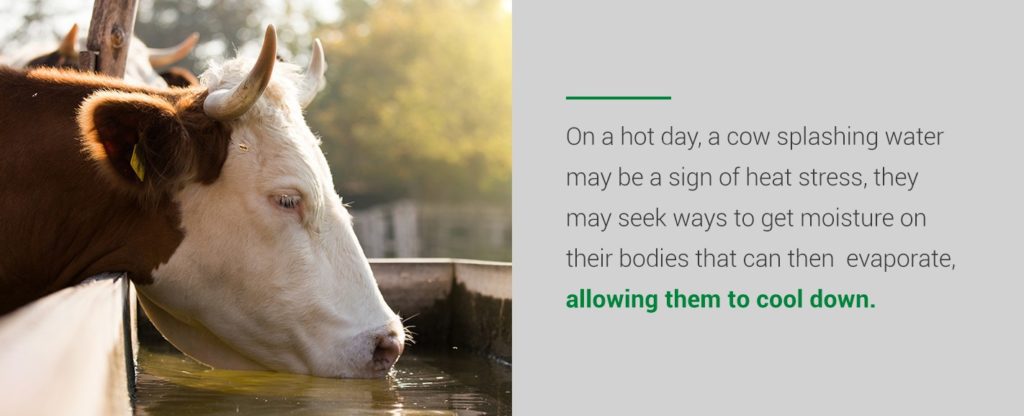 12. Huddling Together
12. Huddling Together
In the winter months, you may notice your cattle grouping together. Cattle stand close in groups during cold weather to share body heat and keep warm. If you see cattle trembling or clustering together in the cold for long periods, your animals may be experiencing cold stress. Since thermoregulation during cold stress is more challenging for cattle than thermoregulation during heat stress, owners must note cold stress as soon as possible and take steps to minimize the stress cattle are experiencing.
Knowing the signs of stress in cattle and calves can help owners minimize stress for their livestock.
Handling Stress in Calves
Minimizing the stress in the cattle’s environment is beneficial not only for calves, but for the people who work with them. Producers will benefit from having happy, healthy cows, so how can you handle stress in calves? Are there ways of reducing stress in a calf?
1. Recognizing Signs
One of the best ways owners can manage stress in calves is by knowing what to look for. If you notice any of the above signs of stress in cattle, take action as soon as possible to lower a calf’s stress levels. Minimizing calf stress can ensure your young animals are healthy and have a good quality of life, which will then increase their production.
2. Provide Accessible Shelter
If your calves are often out in the elements, provide a shelter they can access easily during storms, heat or frigid temperatures. Shelter can help calves avoid weather stress. Since severe weather stress can lead to sickness and even death, providing adequate shelter is a way for producers to minimize this stress calves may experience.
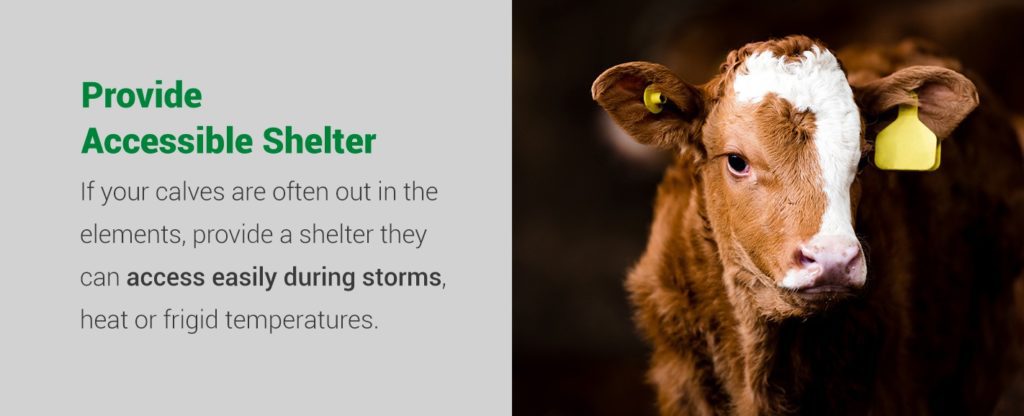 3. Reducing Calf Stress at Weaning
3. Reducing Calf Stress at Weaning
Producers want to raise quality calves to ensure their future. Weaning is one of the most stressful events for calves. Because severe stress can have dire consequences for cattle, producers should go above and beyond to make sure calves are experiencing minimal stress at weaning.
One step producers can take to reduce calf stress at weaning is implementing an effective vaccination program. Calves should receive a clostridial product, a pasteurellosis vaccine and a quality deworming product at the opportune stages of their growth. For example, at birth or turnout, administer clostridial, followed by a second dose a few weeks before weaning. A deworming product can control parasites, which can help reduce calf stress at weaning, as calves will be able to respond more effectively to vaccinations and will be better able to use nutrients from feed.
Considering a calf’s age in regards to weaning is another crucial step to reduce calf stress. When a calf’s age and the weather are more conducive to good health, this may be the optimal time for weaning. A calf may fare better by being weaned at a younger age, under four months old, or when the calf is at least seven months old, as its immune system has developed more if it received the appropriate vaccines. At this age, weaning begins to occur naturally, so leaning into this natural weaning can be a good way for producers to reduce stress on these young animals.
Also, consider weaning earlier in the year, when temperatures are consistent, to reduce calf stress. Even if the weather is hot, this is still a better time of year to wean a calf than during months when the temperature fluctuates, which can compromise the calf’s immune system.
Stress is an external influence that impacts the homeostasis of an animal’s body. Stress can have several negative effects on calves, some of the most vulnerable and valuable animals a producer has. To help your calves handle stress when it’s begun to affect their stomachs, use CattlActive®. This product neutralizes excess acid in a cow stomach that builds up due to stress. CattlActive® can help encourage water and feed consumption, which then allows for the intestines and rumen to begin healing.
To help calves manage or alleviate the effects of stress, try CattlActive®.
Related Posts
- Stress and Cortisol Can Undermine Your Herd Vaccination Programs
- Tips for Improving Profit for Cow-Calf Operations
- How Does the Digestive System Work in a Cow: Understanding the Ruminant Digestive System
Sources
- https://www.ncbi.nlm.nih.gov/pubmed/7240033
- https://www.ncbi.nlm.nih.gov/pubmed/18218157
- https://www.ncbi.nlm.nih.gov/pubmed/18218156

